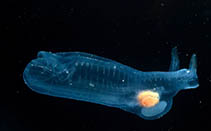Thetys vagina Tilesius, 1802
Virgin salpaWarning: DOMDocument::load(): SSL operation failed with code 1. OpenSSL Error messages: error:140770FC:SSL routines:SSL23_GET_SERVER_HELLO:unknown protocol in C:\Apache24\htdocs\includes\SpeciesSummary.lib.php on line 1236
Warning: DOMDocument::load(): Failed to enable crypto in C:\Apache24\htdocs\includes\SpeciesSummary.lib.php on line 1236
Warning: DOMDocument::load(https://sealifebase.nrm.se/webservice/AquaMaps/getAMap.php?genus=Thetys&species=vagina): failed to open stream: operation failed in C:\Apache24\htdocs\includes\SpeciesSummary.lib.php on line 1236
Warning: DOMDocument::load(): I/O warning : failed to load external entity "https://sealifebase.nrm.se/webservice/AquaMaps/getAMap.php?genus=Thetys&species=vagina" in C:\Apache24\htdocs\includes\SpeciesSummary.lib.php on line 1236
Classification / Names Common names | Synonyms | CoL | ITIS | WoRMS
| Salpida | Salpidae
Environment: milieu / climate zone / depth range / distribution range Ecologia
Pelágico(a,os,as); intervalo de profundidade 0 - 150 m (Ref. 2376). Temperate
Distribuição Países | Áreas FAO | Ecossistemas | Ocorrências | Introduções
Indo-Pacific, Atlantic Ocean and the Mediterranean: from New Zealand to Japan, East Pacific Ocean from California to Bering Sea. Tropical to temperate.
Length at first maturity / Tamanho / Peso / Idade
Maturity: Lm ? range ? - ? cm Max length : 12.0 cm TL macho/indeterminado; (Ref. 1610)
Marine, planktonic; tolerates colder waters than most salps (Refs. 1134, 126266). Associated with an attached phyllosomata of the western rock lobster Panulirus cygnus, which was found to consume its host's tissue, exhibiting opportunistic feeding (Ref. 108806).
Life cycle and mating behavior Maturidade | Reprodução | Desova | Ovos | Fecundidade | Larvas
Members of the order Salpida includes clonal and sexual phases in its life cycle. Life cycle: The oozooid holds in its stolon the buds and blastozooids, each containing an egg. The blastozooid becomes a brood sac for the fertilized egg which later breaks free as a young zooid.
Referência principal
Referências | Coordenador | Colaboradores
Kott, P. 2005. (Ref. 1134)
Status na Lista Vermelha da IUCN (Ref. 130435)
Status no CITES (Ref. 108899)
Not Evaluated
CMS (Ref. 116361)
Not Evaluated
Perigo para os humanos
Uso pelos humanos
| FishSource |
Ferramentas
Mais informação
Idade/Tamanho
Crescimento
Comprimento-peso
Comprimento-comprimento
Morfologia
Larvas
Abundância
Crescimento
Comprimento-peso
Comprimento-comprimento
Morfologia
Larvas
Abundância
Fontes da internet
BHL | BOLD Systems | CISTI | DiscoverLife | FAO(Publication : search) | Fishipedia | GenBank (genoma, nucleotídeo) | GloBI | Gomexsi | Google Books | Google Scholar | Google | PubMed | Árvore da vida | Wikipedia (Ir para, procura) | Registro zoológico
Estimates based on models
Preferred temperature
(Ref. 115969): 7.3 - 24.7, mean 14.8 (based on 2418 cells).
Categoria de preço
(Ref. 80766):
Unknown.



